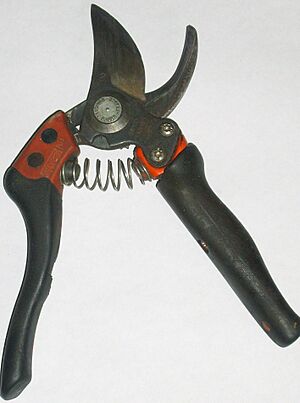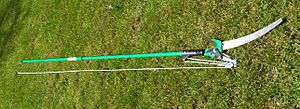Pruners facts for kids
Pruners are special cutting tools. People use them to trim or cut parts of plants. This trimming is called pruning. Pruners help plants grow better and stay healthy.
Contents
What are Pruners?
Pruners are hand tools designed for cutting plants. They are often called snippers or secateurs. Just like the word scissors, pruners is a word that means one tool, even though it ends with an "s".
Most pruners have two handles. One handle is connected to a sharp blade. The other handle is connected to a flat, blunt surface. When you squeeze the handles, the blade cuts against the blunt surface. This makes a clean cut on plant stems.
Types of Pruners
There are different kinds of pruners for different jobs.
Hand Pruners
Hand pruners are small enough to hold in one hand. They are great for cutting small stems and branches. You might use them for trimming rose bushes or grapevines. They are perfect for stems that are about the thickness of a pencil or smaller.
Pole Pruners
A pole pruner is like a regular pruner, but it's attached to a long pole. This helps you reach high branches without needing a ladder. You operate a pole pruner by pulling a rope. This rope makes the blades close and cut the branch. Some pole pruners also have a small saw blade. This lets you cut thicker branches that are out of reach.
What are Pruners Used For?
Pruners are very useful in gardening. They help gardeners:
- Remove dead or damaged parts of plants.
- Shape plants and bushes.
- Encourage new growth.
- Harvest fruits or flowers.
For thicker branches, like those bigger than a pencil, you will need a different tool. Tools like loppers or a saw are better for larger cuts. Using the right tool helps keep both you and the plant safe.
Caring for Your Pruners
To keep your pruners working well, it's important to clean them. After using them, wipe off any plant sap or dirt. You can also sharpen the blades from time to time. This makes sure they always make clean cuts. Clean and sharp pruners help prevent diseases from spreading between plants.



